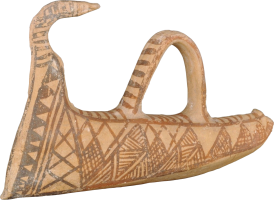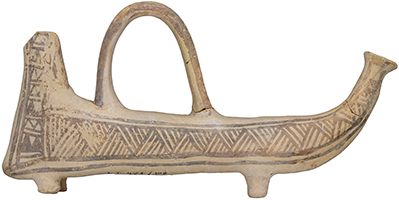Proto-White Painted ware basket handle askos. Flat hull, triangular bow with a slightly inward leaning stempost that has a spur or cutwater. The sternpost forms the cylindrical spout and rises vertically. There is a vertical zigzag design on the sides of the stempost reminiscent of the Tragana ship. On the inner, unpainted edge of the stempost are six horizontal lines. Midway along the hull is an open rower's gallery painted in the typical manner as a horizontal ladder motif.
Ship-shaped askos
C13
LC IIIB (1100-1050 B.C.) type but in an early CGI context (1050-1000)
Lapithos
L: 31 cm
Proto-White Painted ware ship-shaped askos/rhyton with legs and a basket handle. Brownish paint
Nicosia 1943/V-29/1
Basch 1987: 149-50, nos. 313-16; Diakou 2013: 179-80, 951, no. 107; Knapp 2019: 143-144; Pieridou 1965: 87, no. 108; Wachsmann 1998: 151, 187, figs. 7.48A-B, 8.47; Wedde 1999b: 468, pl. XCI: -D5 Tomb 474: Diakou 2013: 141-243, 916-963 (appendix); Pieridou 1965
Cypriot askoi of the EIA come in a wide variety of shapes (bird, fish, zoomorphic, and other miscellaneous forms) yet all share a few main elements in common: they are closed shapes, have a basket handle, and a cylindrical spout that is often funnel shaped (Kourou 1997: 89). The ship-shaped askoi are decorated with geometric motifs that are familiar to Proto-White Painted ware. Some of the painted decoration can be nonetheless plausibly identified as depicting actual ship elements. Two of the models come from Lapithos while one is of unknown provenance. Given that it is very similar to the others it is quite likely to come from Lapithos as well.
Aside from the addition of legs and a basket handle characteristic of askoi in general, there is no reason to suspect that the elongated flat shape of the hull is a distortion to suit the medium, since much squatter, rounder shapes are common for the zoomorphic askoi. In other words, a beamy crescentic vessel could be easily rendered but the artist ostensibly intended to highlight the distinctive slender hull of an oared galley.
Basch, L. 1987. Le musée imaginaire de la marine antique. Athens: Institut Hellénique pour la preservation de la tradition nautique.
Diakou, S. 2013. “Lapithos: the Upper Geometric cemetery.” PhD dissertation, Bryn Mawr College, US.
Knapp, A. B. 2018. Seafaring and Seafarers in the Bronze Age Eastern Mediterranean. Leiden: Sidestone Press.
Pieridou, A. 1965. “An early Cypro-Geometric tomb at Lapethos.” RDAC: 74-111.
Wachsmann, S. 1998. Seagoing Ships & Seamanship in the Bronze Age Levant. College Station, TX: Texas A&M University Press.
Wedde, M. 1999b. “War at Sea: The Mycenaean and Early Iron Age Oared Galley,” in R. Laffineur (ed.) Polemos: Le context guerrier en Égée à l’âge du bronze. Actes de la 7e Rencontre égéenne internationale, Université de Liège, 14–17 Avril 1998. Aegaeum 19. Liège: Université de Liège, pp. 465–427.






